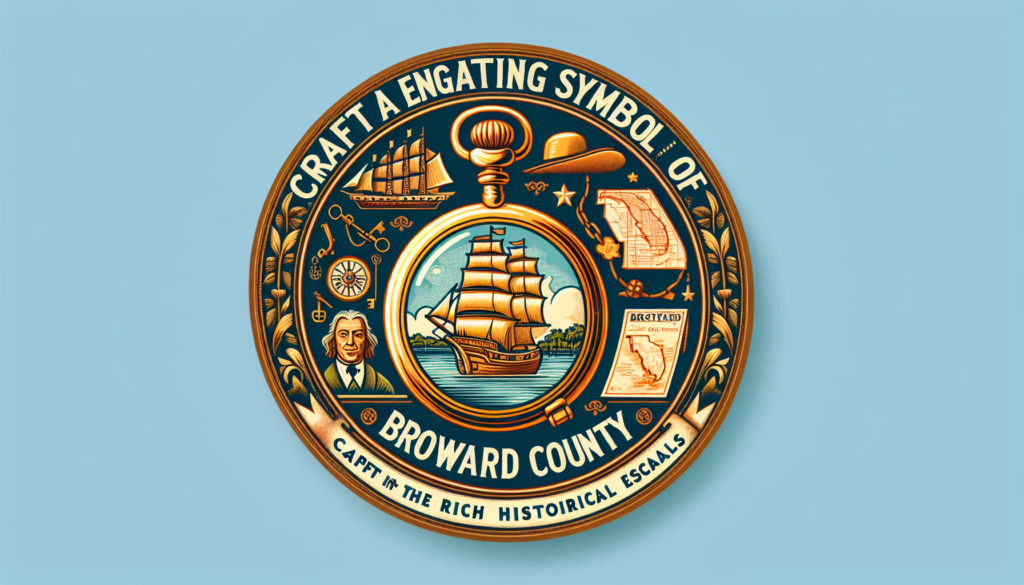Broward County, a vibrant and culturally diverse region nestled in the heart of South Florida, holds within its borders a fascinating tapestry of history waiting to be explored. From its humble beginnings as a desolate wilderness to its growth into a bustling metropolitan area, the historical roots of Broward County run deep. Delve into the captivating narrative of this captivating area, as you uncover tales of pioneers, Native American tribes, and the development that shaped Broward County into what it is today. Embark on a journey through time as you uncover the rich history of Broward County, a treasure trove of stories just waiting to be discovered.
Interested in being advertised as South Florida's Best? Check out their latest promotion!
Exploring the Rich History of Broward County
Broward County, located in the state of Florida, has a rich and diverse history that dates back to the Pre-Columbian era. From the Seminole Tribe and archaeological evidence to early European exploration, pioneer settlers, and 19th-century developments, Broward County’s history is a fascinating tapestry of cultures, events, and progress. This article aims to provide a comprehensive overview of the county’s historical milestones, social and cultural developments, economic growth, and the challenges it has faced in the 21st century.

Pre-Columbian Era
The Seminole Tribe
Before the arrival of European explorers, Broward County was inhabited by the Seminole Tribe, a Native American group who called the region home. The Seminoles had a deep connection to the land and the natural resources it provided. They lived in harmony with nature and left a lasting impact on the county’s cultural heritage.
Archaeological Evidence
Archaeological evidence, such as pottery shards, tools, and shell mounds, attests to the presence of Native American cultures in Broward County. These artifacts provide a glimpse into the daily lives, traditions, and cultural practices of the indigenous people who lived here centuries ago. The archaeological findings serve as a reminder of the county’s ancient roots and the importance of preserving its cultural heritage.
Early European Exploration
Spanish Explorations
In the early 16th century, Spanish explorers ventured into what is now Broward County, seeking new territories and resources. Juan Ponce de León, in his search for the Fountain of Youth, explored the southeastern coast of Florida. Other Spanish explorers followed, establishing a foothold in the region and leaving their mark on the land.
British Rule
Following the defeat of the Spanish, British forces gained control over Florida, including the area that is now Broward County. British rule brought with it a period of relative stability and economic growth. However, this period also saw the influx of British settlers who clashed with the Native American tribes, leading to increased tensions and conflicts.
American Claim
During the 19th century, the United States claimed Florida as a territory, and Broward County became part of this expanding nation. The American presence brought new settlers and the promise of economic development. The county began to attract pioneers from various backgrounds, each contributing to its growth and shaping its future.
Pioneer Settlers
First European Settlers
The early pioneer settlers in Broward County were primarily European immigrants seeking new opportunities and a fresh start. They arrived in the late 19th century and faced numerous challenges, including the harsh environment and conflicts with Native American tribes. However, their perseverance and determination laid the foundation for future generations to thrive in this new frontier.
Development of Agriculture
One of the key developments brought by the pioneer settlers was the establishment of agriculture. The fertile land and favorable climate allowed for the cultivation of crops such as citrus fruits, tomatoes, and beans. Agriculture became a significant economic driver in the county, attracting more settlers and contributing to its growth.
Conflict with Native Americans
As settlers encroached on Native American lands, conflicts between the two groups became inevitable. This resulted in several military clashes and the displacement of Native American tribes, including the Seminoles, who were forced to relocate further south. The legacy of these conflicts shapes the history and cultural landscape of Broward County to this day.
19th Century Developments
The Florida East Coast Railway
In the late 19th century, the development of the Florida East Coast Railway transformed Broward County by connecting it to the broader transportation network. This railway opened up opportunities for trade, tourism, and commerce, bringing further economic growth and development to the county.
Growth of Fort Lauderdale
The early 20th century saw the rapid growth and development of Fort Lauderdale, the county seat of Broward County. The city’s proximity to the coastline and the establishment of a deepwater port played a significant role in its expansion. Fort Lauderdale quickly became a hub for tourism and attracted visitors from around the country.
Impact of World War II
World War II had a profound impact on Broward County. The county became home to several military bases and training facilities, which brought an influx of personnel and boosted the local economy. The war also accelerated the region’s urbanization and development, laying the groundwork for its future growth and transformation.

Civil Rights and Desegregation
Segregation in Broward County
Like many parts of the United States, Broward County experienced a history of racial segregation. African Americans faced discrimination and were subjected to unjust laws and practices that limited their opportunities and inflicted social and economic inequality. This era of segregation left a lasting impact on the county’s social fabric.
The Civil Rights Movement
The Civil Rights Movement of the 1960s had a significant impact on Broward County. Activists and community leaders fought for racial equality, challenging the systemic discrimination that had persisted for decades. Their efforts led to gradual changes and advancements in civil rights, paving the way for a more inclusive and equitable society.
Desegregation Efforts
Desegregation efforts in Broward County, particularly in public schools, were met with resistance and controversy. The county faced challenges in implementing desegregation policies, and it took considerable time and perseverance to break down the racial barriers and achieve true integration. However, these efforts laid the foundation for a more diverse and inclusive community.
Natural Disasters and Environmental Conservation
Hurricane Andrew
In 1992, Broward County experienced the devastating impact of Hurricane Andrew. This powerful storm caused widespread destruction and loss of life, emphasizing the need for improved disaster preparedness and response. The county’s resilience and ability to recover from such disasters have become integral parts of its history.
Everglades Restoration
Broward County is home to a portion of the endangered Everglades ecosystem, one of the most unique and vital natural environments in the United States. Efforts to restore and protect the Everglades have gained prominence in recent years, highlighting the importance of conservation and the preservation of this fragile ecosystem.
Conservation Efforts
In addition to the Everglades, Broward County has made strides in environmental conservation. Initiatives such as beach preservation, wildlife protection, and sustainable development have been implemented to ensure the long-term preservation of the county’s natural resources. These efforts balance economic growth and environmental stewardship, making Broward County a leader in sustainability.
Social and Cultural History
Diversity in Broward County
Broward County is known for its diversity, with residents hailing from various cultural, ethnic, and religious backgrounds. The county’s population is a vibrant mosaic of people, each contributing to its unique social fabric. This diversity fosters a rich and inclusive community that celebrates different traditions and values.
Impact of Tourism
Tourism has played a significant role in shaping the social and cultural history of Broward County. The county’s pristine beaches, vibrant nightlife, and cultural attractions have attracted visitors from around the world. The tourism industry has not only provided economic opportunities but has also contributed to the county’s cultural exchange and understanding.
Cultural Institutions
Broward County is home to numerous cultural institutions that celebrate its diverse heritage. Museums, art galleries, and performance venues showcase the county’s artistic endeavors and contribute to its cultural landscape. These institutions play a crucial role in preserving the county’s history and promoting artistic expression.
Economic Growth and Development
The Port Everglades
Port Everglades, one of the busiest cruise ports in the world, has been a significant driver of economic growth in Broward County. The port serves as a gateway to international commerce, facilitating trade and contributing to the county’s economic prosperity. Its strategic location and state-of-the-art facilities have made it an essential economic asset.
The Sawgrass Mills Mall
The Sawgrass Mills Mall, the largest outlet and value retail shopping destination in the United States, has had a substantial impact on Broward County’s economy. The mall attracts millions of visitors each year, providing job opportunities and generating revenue for the local community. Its success has transformed the county into a premier shopping destination.
The Broward County Convention Center
The Broward County Convention Center has played a pivotal role in promoting economic growth and development. This state-of-the-art facility hosts conventions, conferences, and trade shows, attracting businesses and visitors from around the world. The center’s events showcase the county’s capabilities, promote networking, and stimulate economic activity.
The 21st Century
Population Growth
Broward County has experienced significant population growth in the 21st century. The county’s favorable climate, economic opportunities, and quality of life have attracted people from across the United States and abroad. This population growth has brought both opportunities and challenges, shaping the county’s present and future.
Urban Development
The 21st century has witnessed rapid urban development in Broward County. New residential, commercial, and infrastructure projects have transformed the skyline and created modern urban centers. However, this growth has also raised concerns about sustainability, gentrification, and preserving the county’s unique character.
Challenges and Future Prospects
Broward County faces several challenges as it looks to the future. Managing population growth, addressing climate change, ensuring social equity, and balancing economic development with environmental conservation are among the key issues the county must navigate. However, with a strong commitment to innovation, sustainable practices, and inclusive governance, Broward County has the potential to thrive in the years to come.
Preservation and Heritage
Historical Preservation Efforts
Preserving Broward County’s historical sites and landmarks is crucial for maintaining its heritage. Efforts to protect and restore historical buildings, archaeological sites, and cultural landmarks ensure that future generations can appreciate and learn from the county’s past. Historical preservation also contributes to tourism and fosters a sense of pride among residents.
Heritage Tourism
Heritage tourism plays a significant role in promoting the county’s historical and cultural assets. Visitors can explore museums, historical sites, and cultural events that showcase Broward County’s unique heritage. Heritage tourism not only supports the local economy but also fosters a deeper understanding and appreciation of the county’s history among visitors and residents alike.
Educational Initiatives
Educational initiatives are vital for ensuring the preservation of Broward County’s history for future generations. Educational programs, curriculum development, and community engagement efforts help instill a sense of pride and appreciation for the county’s heritage in schools and throughout the community. By fostering an understanding of its past, Broward County can shape a more informed and engaged citizenry.
In conclusion, Broward County’s history is a dynamic tapestry that weaves together the stories of diverse cultures, economic development, social progress, and environmental conservation. From the Pre-Columbian era to the challenges and prospects of the 21st century, Broward County’s rich heritage is a testament to the resilience, innovation, and creativity of its people. By preserving its history, celebrating its diversity, and embracing sustainable practices, Broward County can build a brighter future while honoring its past.


Recent Comments